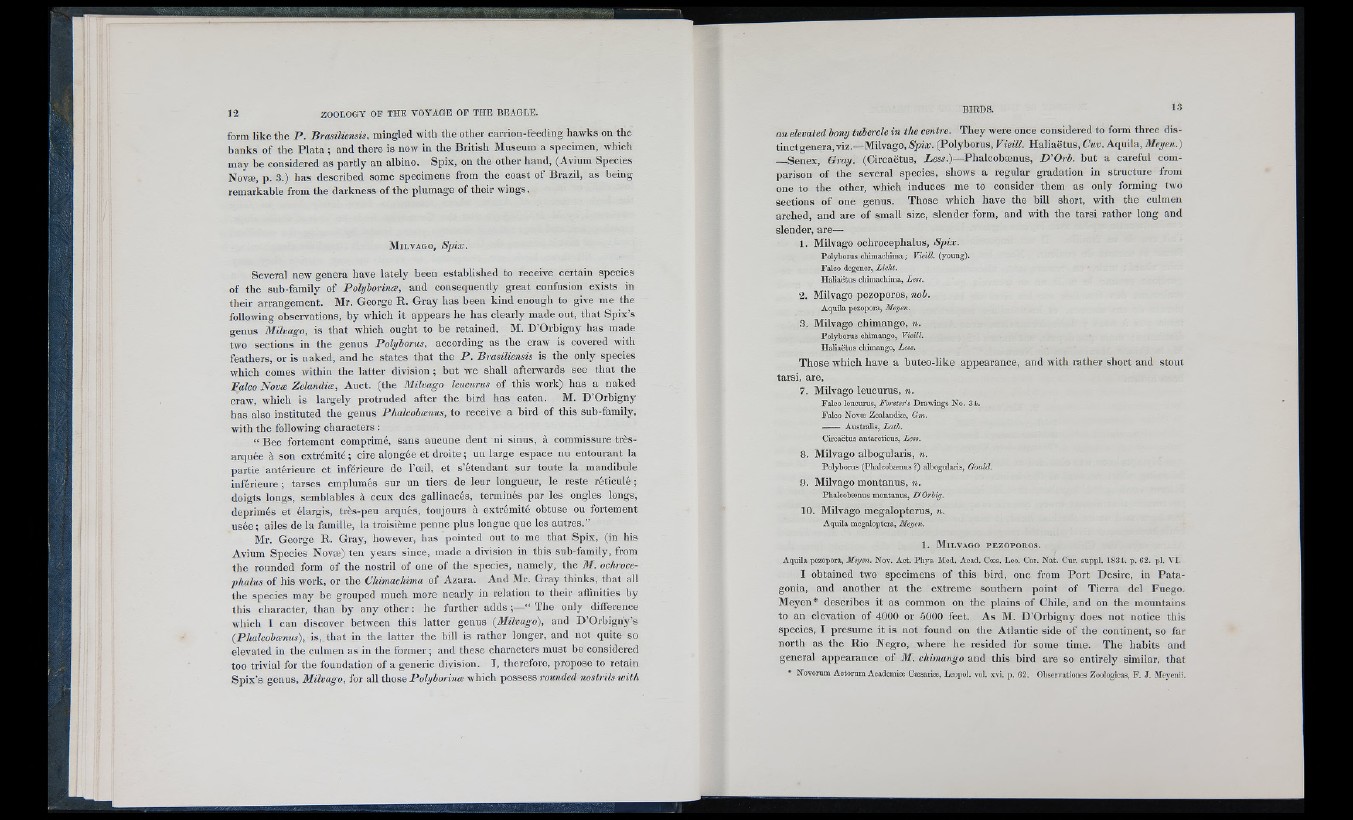
form like the P . Brasiliensis, mingled with the other carrion-feeding hawks on the
banks of the Plata ; and there is now in tlie British Museum a specimen, which
may be considered as partly an albino. Spix, on the other hand, (Avium Species
Novæ, p. 3.) has described some specimens from the coast of Brazil, as being
remarkable from the darkness of the plumage of their wings.
M i l v a g o , Spix.
Several new genera have lately been establislied to receive certain species
of the sub-family of Pohjhorinæ, and consequently great confusion exists in
their arrangement. Mr. George R. Gray has been kind enough to give me the
following observations, by which it appears he has clearly made out, that Spix’s
genus Milvago, is that which ought to be retained. M. D’Orbigny has made
two sections in the genus Polyhorus, according as the craw is covered with
feathers, or is naked, and he states that the P . Brasiliensis is the only species
which comes within the latter division ; but we shall afterwards see that the
Falco Novæ Zelandiæ, Auct. (the Milvago leucnrns of this work) has a naked
craw, which is largely protruded after the bird has eaten. M. D ’Orbigny
has also instituted the genus Phalcobænus, to receive a bird of this sub-family,
with the following characters :
“ Bee fortement comprimé, sans aucune dent ni sinus, à commissure très-
arquée à son extrémité ; cire alongée et droite ; un large espace nu entourant la
partie antérieure et inférieure de l’oeil, et s’étendant sur toute la mandibule
inférieure ; tarses emplumés sur un tiers de leur longueur, le reste réticulé ;
doigts longs, semblables à ceux des gallinacés, terminés par les ongles longs,
déprimés et élargis, très-peu arqués, toujours à extrémité obtuse ou fortement
usée ; ailes de la famille, la troisième penne plus longue que les autres.”
Mr. George R. Gray, however, has pointed out to me that Spix, (in his
Avium Species Novæ) ten years since, made a division in this sub-family, from
the rounded form of the nostril of one of the species, namely, the Tif. ochroce-
phalus of his work, or the Vhimachima of Azara. And Mr. Gray thinks, that all
tlie species may be grouped much more nearly in relation to tlieir affinities by
this character, than by any other : he further adds ;—“ The only difference
wliich I can discover between this latter genus {Milvago), and D ’Orbighy’s
{Phalcobænus), is, that in the latter the bill is rather longer, and not quite so
elevated in the culmen as in the former ; and these characters must he considered
too trivial for the foundation of a generic division. I, tlierefore, propose to retain
Spix’s genus, Milvago, for all those Polyborinæ which possess rounded nostrils with
an elevated bony tubercle in the centre. Tliey were once considered to form three distinct
genera, viz.—Milvago, Spix. (Polyborus, VieiU. Haliaëtus, Cuv. Aquila, Meyen.)
Senex, Gray. (Circaëtus, Less.)—Phalcobænus, D ’Orb. hut a careful comparison
of the several species, shows a regular gradation in structure from
one to the other, which induces me to consider them as only forming two
sections of one genus. Those which have the hill short, with the culmen
arched, and are of small size, slender form, and with the tarsi rather long and
slender, are—
1. Milvago ochrocephalus, Spix.
Polyborus chimachima; Vieill. (young).
Falco degencr, Licht.
Haliaëtus chimacbima, L m .
2. Milvago pezoporos, nob.
Aquila pezopora, Meym.
3. Milvago chimango, n.
Polyborus chimango, Vieill.
Haliaëtus chimango, Less.
Those which have a buteo-like appearance, and with rather short and stout
tarsi, are,
7. Milvago leucurus, n.
Falco leucurus, Forsters Drawings No. 34.
Falco Novæ Zealandiæ, Om.
Australis, Lath.
Circaëtus antarcticus. Less.
8. Milvago albogularis, n.
Polyborus (Phalcobænus ?) albogularis, Gould.
9. Milvago montanus, n.
Phalcobænus montanus, UOrUg.
10. Milvago megalopterus, n.
Aquila megaloptera, Meyen.
1 . M il v a g o p e z o p o r o s .
Aquila pezopora, Meyen. Nov. Act. Phys. Med. Acad. Coes. Leo. Car. Nat. Cur. suppl. 1834. p. 62. pi. YI.
I obtained two specimens of this bird, one from Port Desire, in Patagonia,
and another at the extreme southern point of Tierra del Fuego.
Meyen* describes it as common on the plains of Chile, and on the mountains
to an elevation of 4000 or 5000 feet. As M. D ’Orbigny does not notice this
species, I presume it is not found on the Atlantic side of the continent, so far
north as the Rio Negro, where he resided for some time. The habits and
general appearance of M. chimango and this bird are so entirely similar, that
* Novorum Actoruui Academioe Cæsarioe, Leopol. vol. xvi. p. 62. Obscrvationes Zoologicas, F. J. Meyenii.